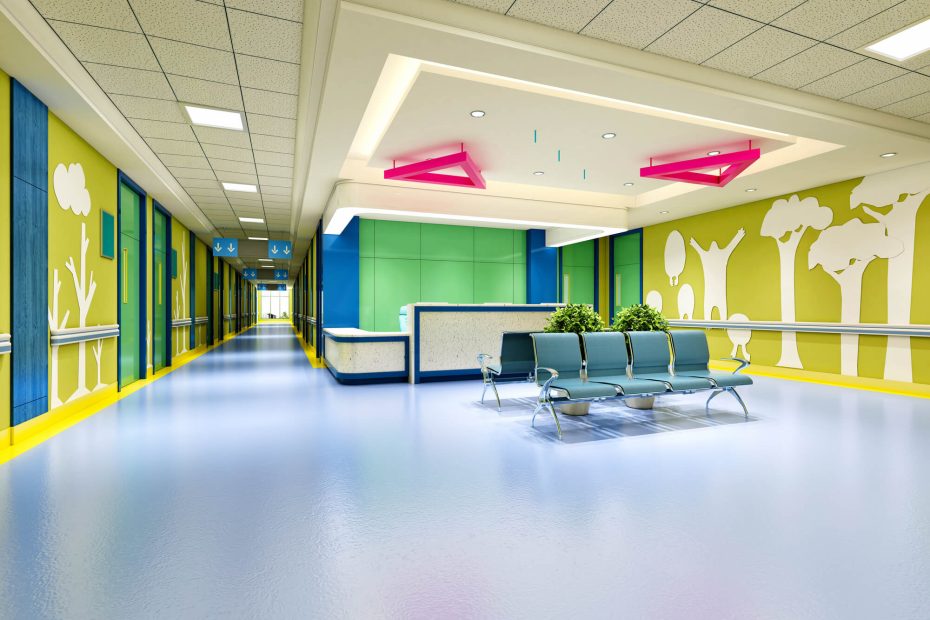What do you imagine when you hear the word “hospital”? Chances are, you think of the classical white and sterile halls often depicted in medical dramas – a featureless environment that is nondescript to reflect the solemnity of illness. However, in the past few decades, there has been a shift in health care toward more purposeful design choices to make hospitals more conducive to healing.
I witnessed firsthand the power art can have on a patient’s well-being when I was working with my preceptor in her pediatrics practice a few weeks ago. Each exam room within the clinic is decorated with a different “fun” theme, ranging from outer space to Alice in Wonderland and even sports teams to capture widespread interests across ages. When a shy 5-year-old first came in for his appointment, he kept hiding behind his dad and would not allow me to complete his physical exam. However, once he noticed the colorful fish hanging from the ceiling in the Under the Sea room, his face lit up. He started to count the fish by color and with each “one fish, two fish, red fish, blue fish,” he calmed down and allowed me to finish his check-up. Seeing how the room’s decoration facilitated the visit made me think for the first time about the intentionality behind a medical facility’s design choices.
The idea that a patient’s environment might impact their healing first started gaining traction in the late 20th century, when a study explored how the view through a patient’s window, post-surgery — either a brick wall or a natural scene —affected their recovery.1 The results were groundbreaking: Patients in rooms looking out to nature were found to have fewer post-operative complications, fewer negative nurse notes and a lower intake of painkillers. This transformative study was one of the first to show that healing is a multifactorial process, influencing hospitals to consider how their aesthetic choices might affect their patients’ health.
Since then, several other studies have confirmed that clinical visuals, particularly art and architecture, impact patient outcomes. In addition, visual stimuli showcasing nature through videos or paintings have been shown to increase pain tolerance2 and decrease post-surgical pain.3
But how can the environment influence tangible patient outcomes?
Evidence-based design proposes three main theories on how hospital art can have a positive impact on patient experience.4 The first is the biophilia hypothesis, which states that through evolution, humans have become predisposed to be drawn to nature as these environments provide the best survival advantage. In modern times, this manifests as people getting positive feelings from nature and natural artwork — a tendency that hospitals can take advantage of when designing their facilities through patient-centric lenses. On the other hand, the distraction theory suggests that visual art can positively impact patients by holding their attention and taking their mind off their pain or anxiety, as I saw happen with the child counting fish. Lastly, certain colors such as green and blue tend to have a calming effect that can elicit positive emotions in patients.
Hospitals all around the world are joining the evidence-based design movement, including here at Johns Hopkins! You can read more about The Johns Hopkins Hospital’s stylistic choices and design partners here.
References
- Ulrich, R. S. (1984). View through a window may influence recovery from surgery. science, 224(4647), 420-421.
- Tse, M. M., Ng, J. K., Chung, J. W., & Wong, T. K. (2002). The effect of visual stimuli on pain threshold and tolerance. Journal of clinical nursing, 11(4), 462-469.
- Diette, G. B., Lechtzin, N., Haponik, E., Devrotes, A., & Rubin, H. R. (2003). Distraction therapy with nature sights and sounds reduces pain during flexible bronchoscopy: A complementary approach to routine analgesia. Chest, 123(3), 941-948.
- Lankston, L., Cusack, P., Fremantle, C., & Isles, C. (2010). Visual art in hospitals: case studies and review of the evidence. Journal of the Royal Society of Medicine, 103(12), 490-499.
Related Content
- Hospital Buildings: An Under-Appreciated Art (and Science)
- Put a Little LOVE in Your Art: Murals of Baltimore
- O, Deadly Majolica
Want to read more from the Johns Hopkins School of Medicine? Subscribe to the Biomedical Odyssey blog and receive new posts directly in your inbox.
